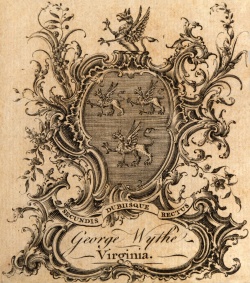Works of the Reverend and Learned John Lightfoot
by Reverend John Lightfoot
| Lightfoot's Works | ||
|
at the College of William & Mary. |
||
| Author | Reverend John Lightfoot | |
| Published | London: Printed by W. R. for Robert Scot, Thomas Basset, Richard Chiswell | |
| Date | 1684 | |
John Lightfoot was born to a Vicar's family at Stoke-upon-Trent, Staffordshire on March 29, 1602.[1][2] He was educated at Christ College in Cambridge and Trinity College in Dublin, where he obtained his bachelor, masters, and doctorate degrees.[3] After he graduated, he joined the church and was first settled at Norton where he met Sir Rowland Cotton Knight who introduced him to Hebrew.[4] For the next several years, Reverend Lightfoot would travel to London, Uttoxetar, Stone, and then back to London.[5] During his second time in London, he became a Member of the Assembly of Divines at Westminster.[6] During this time, Reverend Lightfoot often disagreed and argued with his fellow members about various Church decisions and protocols. [7] Some of these decision included whether to preach on Christmas day, make court consist of Lay Elders, and the election of Ministers by their parish.[8] In 1643, Reverend Lightfoot moved to the rectory of Much-Munden, at which place he stayed until his death in 1675.[9] In 1655, Reverend Lightfoot added to his honors when he was chosen as Vice-Chancellor of the University of Cambridge.[10] At the end of his life, Reverend John Lightfoot was known for being a great orator, rabbinical scholar,author, and English churchman.[11]
The Works of the Reverend and Learned John Lightfoot is a collection of Reverend Lightfoot's previous and unpublished works which were published posthumously.[12] The book is made of two volumes which are further subdivided into eleven sections, ten tables, seven exercitations, and a hand drawn map of Jerusalem.[13] Both volumes deal with analyzing the Bible, including the Old Testament and the New Testament.[14] The beginning of the book is a biography about Lightfoot which seems to have been done by various friends. The works that Lightfoot display, mixes theology with rabbinical history to try to gain more knowledge about the Bible and the lives of those in it.[15]
Evidence for Inclusion in Wythe's Library
Wythe's copy owned by the Library of Congress, with an 1815 bookplate. Volume 1 has Wythe's signature on the title page, and manuscript notes, throughout.[16] However, it is not listed on Jefferson's copy of the inventory of books he inherited from George Wythe in 1806.
George Wythe Munford (1803 – 1882), the son of one of Wythe's students, William Munford, twice mentions in The Two Parsons (1884) that in his later life George Wythe had studied Hebrew with a rabbi named Seixas in Richmond, Virginia.[17]
See also
References
- ↑ Lightfoot, John (1602–1675)" in Oxford Dictionary of National Biography, accessed March 7 2023.
- ↑ Lightfoot, John. The Works of the Reverend and Learned John Lightfoot. London: W.R. for Robert Scot, Thomas Basset, Richard Chiswell, 1684.
- ↑ Ibid.
- ↑ Ibid.
- ↑ Ibid.
- ↑ Ibid.
- ↑ Ibid.
- ↑ Ibid.
- ↑ Ibid.
- ↑ Ibid.
- ↑ "John Lightfoot." Christian Classics Ethereal Library.https://www.ccel.org/ccel/lightfoot (Accessed December 6,2018).
- ↑ Lightfoot, The Works of the Reverend and Learned John Lightfoot.
- ↑ Ibid.
- ↑ Ibid.
- ↑ Lightfoot, The Works of the Reverend and Learned John Lightfoot.
- ↑ Library of Congress catalog record.
- ↑ George Wythe Munford, The Two Parsons; Cupid's Sports; The Dream; and The Jewels of Virginia (Richmond, Virginia: J.D.K. Sleight, 1884), 364, 417.
External links
Read volume of this work in Google Books.
